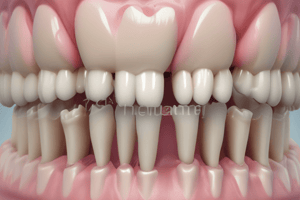Podcast
Questions and Answers
What is the term used to describe placing an implant in consideration of the final prosthesis?
What is the term used to describe placing an implant in consideration of the final prosthesis?
- Osteointegration technique
- Prosthetic-driven implant placement (correct)
- Traditional bone-based implant placement
- Soft tissue augmentation
In the context of implant restoration, what aspect plays a crucial role in determining the success of implants?
In the context of implant restoration, what aspect plays a crucial role in determining the success of implants?
- Maxillary incisal edge modification
- Orthodontic treatment approach
- Buckle horizontal position assessment
- Final prosthesis design (correct)
What does the concept of 'strategic planning for interior implant restorations being paramount' imply?
What does the concept of 'strategic planning for interior implant restorations being paramount' imply?
- Placing implants without considering soft tissue augmentation
- Considering the final prosthesis position before implant placement (correct)
- Placing implants based solely on bone availability
- Ignoring prosthetic concerns in implant planning
Why is it no longer sufficient to place implants solely based on bone availability?
Why is it no longer sufficient to place implants solely based on bone availability?
What concept emphasizes designing the anterior prosthesis before determining the implant position?
What concept emphasizes designing the anterior prosthesis before determining the implant position?
What is the purpose of adding pink acrylic or pink ceramic to a restoration in prosthetic intervention?
What is the purpose of adding pink acrylic or pink ceramic to a restoration in prosthetic intervention?
In what situation would a prosthetic intervention involve FP2 type restoration?
In what situation would a prosthetic intervention involve FP2 type restoration?
How does increasing the number of implants impact prosthetic restoration?
How does increasing the number of implants impact prosthetic restoration?
What is the classification of prosthetic intervention that involves restoring the tooth only?
What is the classification of prosthetic intervention that involves restoring the tooth only?
How does FP3 type restoration differ from FP2 in prosthetic intervention?
How does FP3 type restoration differ from FP2 in prosthetic intervention?
What is the purpose of using a custom healing abutment during implant placement?
What is the purpose of using a custom healing abutment during implant placement?
What is the primary function of the implant analog used in the impression-making process?
What is the primary function of the implant analog used in the impression-making process?
What is the purpose of filling the space around the implant analog with impression material or pattern resin?
What is the purpose of filling the space around the implant analog with impression material or pattern resin?
Which of the following is the most important factor to consider when selecting the material for the provisional restoration?
Which of the following is the most important factor to consider when selecting the material for the provisional restoration?
How does the use of a provisional restoration during implant treatment differ from its use in conventional fixed prosthodontics?
How does the use of a provisional restoration during implant treatment differ from its use in conventional fixed prosthodontics?
What is the first aspect that should be assessed in the beginning when considering pre-implant prosthetic factors?
What is the first aspect that should be assessed in the beginning when considering pre-implant prosthetic factors?
In the context of prosthetic intervention, what is considered the most crucial factor according to the text?
In the context of prosthetic intervention, what is considered the most crucial factor according to the text?
What concept should be approached together from both a prosthetic and surgical perspective?
What concept should be approached together from both a prosthetic and surgical perspective?
Which aspect is emphasized as important before deciding on an implant placement and restoration?
Which aspect is emphasized as important before deciding on an implant placement and restoration?
What is the initial assessment that should be made when considering pre-implant prosthetic factors?
What is the initial assessment that should be made when considering pre-implant prosthetic factors?
What type of prosthesis is primarily supported by the mucosa and secondarily retained by implants?
What type of prosthesis is primarily supported by the mucosa and secondarily retained by implants?
Which factor determines whether pink acrylic or ceramic is used for the FP3 prosthesis?
Which factor determines whether pink acrylic or ceramic is used for the FP3 prosthesis?
If a patient has a high smile line, which prosthesis type would be most appropriate to address aesthetic concerns?
If a patient has a high smile line, which prosthesis type would be most appropriate to address aesthetic concerns?
Which statement about the different fixed prosthesis types is correct?
Which statement about the different fixed prosthesis types is correct?
Based on the information provided, which prosthesis type is being demonstrated in the image described as 'what you're going to do next year in the clinic'?
Based on the information provided, which prosthesis type is being demonstrated in the image described as 'what you're going to do next year in the clinic'?
What is the ideal distance between the implant placement and the free gingival margin?
What is the ideal distance between the implant placement and the free gingival margin?
What is the purpose of creating an emergence profile for an anterior implant?
What is the purpose of creating an emergence profile for an anterior implant?
What technique is suggested for capturing the emergence profile during the impression-taking process?
What technique is suggested for capturing the emergence profile during the impression-taking process?
What is the primary tissue component that surrounds the implant and contributes to the emergence profile?
What is the primary tissue component that surrounds the implant and contributes to the emergence profile?
What is the term used to describe the circular epithelial structure surrounding the implant?
What is the term used to describe the circular epithelial structure surrounding the implant?
What is the primary consideration for determining the success of a maxillary anterior implant, beyond just osseointegration?
What is the primary consideration for determining the success of a maxillary anterior implant, beyond just osseointegration?
What is a key difference in the considerations for restoring an implant in tooth #3 versus tooth #9 in the maxillary anterior region?
What is a key difference in the considerations for restoring an implant in tooth #3 versus tooth #9 in the maxillary anterior region?
Which of the following best describes a 'clinically successful' maxillary anterior implant, as described in the text?
Which of the following best describes a 'clinically successful' maxillary anterior implant, as described in the text?
What is a key aspect of treatment planning for maxillary anterior implants, as emphasized in the text?
What is a key aspect of treatment planning for maxillary anterior implants, as emphasized in the text?
What is a limitation of the previous concept that an implant is successful if it is only osseointegrated?
What is a limitation of the previous concept that an implant is successful if it is only osseointegrated?
What is the primary reason why it is no longer sufficient to place implants solely based on bone availability in the maxillary anterior region?
What is the primary reason why it is no longer sufficient to place implants solely based on bone availability in the maxillary anterior region?
Which of the following best describes the concept of 'strategic planning for anterior implant restorations' mentioned in the text?
Which of the following best describes the concept of 'strategic planning for anterior implant restorations' mentioned in the text?
What is the primary reason why the previous concept of implant success based solely on osseointegration is no longer considered adequate?
What is the primary reason why the previous concept of implant success based solely on osseointegration is no longer considered adequate?
What is the main difference between a 'successful' maxillary anterior implant and one that is 'not successful', as described in the text?
What is the main difference between a 'successful' maxillary anterior implant and one that is 'not successful', as described in the text?
What is the primary focus of the 'strategic planning' approach for maxillary anterior implant restorations, as emphasized in the text?
What is the primary focus of the 'strategic planning' approach for maxillary anterior implant restorations, as emphasized in the text?
Flashcards are hidden until you start studying
Study Notes
Strategic Planning for Interior Implant Restorations
- Strategic planning is crucial for successful interior implant restorations, considering factors like hard and soft tissue augmentation.
- Prosthetic-driven implant placement is essential, taking into account the final prosthesis and its position in relation to the bone.
Prosthetic Classifications
- There are two main types of prosthetics: fixed and removable.
- Fixed prosthetics can be classified into three types: FP1, FP2, and FP3.
- FP1 involves restoring only the tooth, FP2 involves over-contouring the restoration to include part of the root, and FP3 involves adding pink esthetics to the restoration.
- FP3 is often used in anterior implants to create an emergence profile.
Importance of Emergence Profile
- The emergence profile is critical in creating a natural-looking restoration, especially in anterior implants.
- It can be achieved through provisionals and captured during impression-taking.
- A custom healing abutment or a provisional implant can be used to create the emergence profile.
Pre-Implant Prosthetic Factors
- Important factors to consider before implant placement and restoration include:
- Maxillary anterior teeth position
- Vertical dimension
- Mandibular incisal edge
- Occlusal plane
Implant Supported Removable Partial Dentures
- Implant supported removable partial dentures can be classified into five types, with FP5 being an implant-supported removable partial denture that relies on mucosal support for its retention and stability.
Smile Line and Gingiva
- The smile line and gingiva are important considerations in prosthetic design, especially in anterior implants.
- A high smile line, medium or average smile line, or a low smile line can affect the type of prosthesis used.
Capturing Emergence Profile with Impressions
- Capturing the emergence profile is crucial in creating a successful restoration.
- A special method of impression-taking can be used to capture the emergence profile.
Biological Aspects of Implant Success
- Implant success is not just about osteo integration, but also about achieving a fully functional and aesthetically pleasing restoration.
- Biological aspects to consider include soft tissue, junctional epithelium, and circular epithelium.
Special Considerations for Implants in the Anterior Sector
- Implants in the anterior sector require precise diagnosis and tailored treatment options.
- Considerations for restoring an implant in the anterior sector are different from those in other areas.
Studying That Suits You
Use AI to generate personalized quizzes and flashcards to suit your learning preferences.




